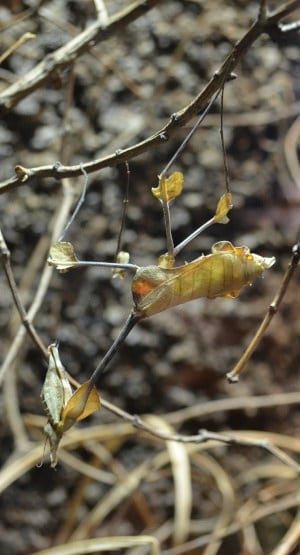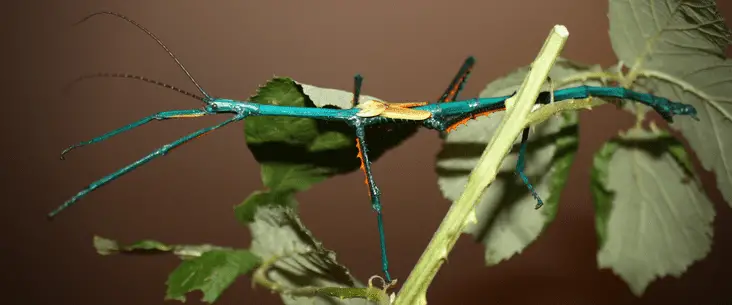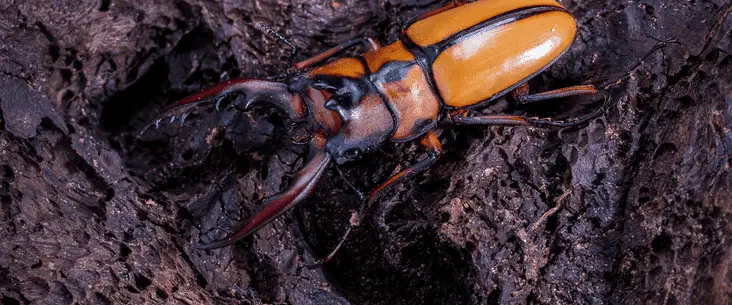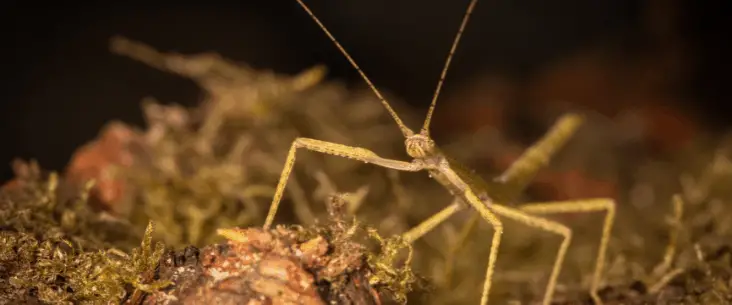The wandering violin mantis (Gongylus gongylodes) is one of the most fascinating looking praying mantis species that you can keep as a pet (and my personal favourite). Although this praying mantis species can be a bit more difficult to keep, with this care guide, you have all the knowledge to properly house and care for them. It is an incredible species for the more experienced insect keeper.
This praying mantis shows some of the best camouflage that is seen in the mantis world. They are quite large and come in a range of colours from light brown to almost black. Although rare, some come in green colour phases during one of its life stages.
In this care guide, we will discuss all you need to know about the housing, environmental conditions, how to feed them, clean them and breed them. But first, we will have a closer look at the wandering violin mantis species itself.
About the wandering violin mantis

Appearance and camouflage
This praying mantis is one of the most bizarre-looking mantises out there. Their long prothorax makes them quite unique, and this feature is also what gives its name. When sitting still, it resembles a violin. The appendages around its legs and abdomen resemble dried leaves.
Most wandering violin mantises comes in light to dark brown colours. It can colour almost black or light green in some of its life stages, but this is very rare to occur.
This mantis species is rather large. The females can get up to 11 cm (4.3″), where the males are smaller and thinner and get up to 9 cm (3.5″). Nymphs look like miniature versions of the adults and are coloured very light brown. When they just hatched, they are no larger than 1.5 cm (0.5″).
Sexing of this mantis species is quite easy and can be done from L4. You can count 8 segments with males, where females only have 6. Females have 5 visible abdominal appendances — like spines at their abdomen — where males have 6 (although the last one is usually smaller). As adults, males have thick feathery antennae (which detect the smell of females) and full-grown wings covering its whole abdomen. Females have thin antennae, and the wings only cover around 75% of their abdomen.
This mantis species belongs to the group of Empusidae, and with every species in that group lack the adhesion organs at the end of their legs. Therefore they can’t climb smooth surfaces and they need rough materials (e.g. branches) to move around in their enclosure.
Behaviour, temperament and handling
Wandering violin mantises are very calm and quiet species. They are typical sit and wait for prey to ambush, and don’t actively hunt for food. It won’t move around a lot in the enclosure. You often see them waving — like a sort of dancing — when hanging on a branch. This behaviour is part of their camouflage, where they mimic a dead leaf or twig waving in the wind.
Although they are very calm in the enclosure, they can be skittish when disturbed. When intimidated they will display their deimatic display — it will raise their front arms and make itself larger to intimidate you, showing the pink and black spots on its forearms.
It won’t attack you and is not aggressive. You can handle them and let them walk on your hand. Be aware that adult males can fly very well and fly long distances when they get the chance. Females and subadults won’t fly. These mantises (especially nymphs) are fragile, and many don’t really like to be handled.
Are you new to keeping praying mantises?
Are you considering keeping mantises as a pet, but you are a complete beginner to the keeping of praying mantises? Keeping and caring for praying mantises is not difficult, but it is important to know what you are doing. The guide on the basics of keeping praying mantis will provide all you need to know to keep a praying mantis as a pet successfully. Please go check it out!

Keeping wandering violin mantises as a pet
Before you can buy your first wandering violin mantis, you first need to create a proper environment for them. This includes a good-sized enclosure and creating a climate that is suitable for them to live in.
Housing requirements
It starts with a proper enclosure. The enclosure is the backbone to create an optimal environment to keep your mantises alive, healthy and happy. Just put them in a jar or container is not enough. The enclosure needs to have certain features and size for them to be suitable.
Enclosure size
As with all mantises, the height of the enclosure is more important than the width. They need the height to moult without touching the ground to remove themselves from their moulted skin. The general rule is that the enclosure needs to be at least 3 times the body length in height, and at least two times the body length in width.
For a single adult wandering violin mantis an enclosure with the size of 20cm x 20cm x 30cm (8″ x 8″ x 12″) will suffice. This size enclosure is also suitable for multiple little nymphs, but be careful that it will not become too crowded.
Wandering violin mantises is one of few mantises that are not highly cannibalistic, which means you can keep them in (small) groups safely all their lives. See more about group housing this species in the breeding tips or additional notes.
If you like to have more mantises in one enclosure, you should keep them in a larger enclosure. Because of the risk of cannibalism, you should keep 10 adult praying mantises in an enclosure with a size of at least 60cm x 60cm x 90cm (24″ x 24″ x 35″).
Essential features of the enclosure
This mantis species needs an enclosure that has good ventilation. It is advised that there are two places where there is sufficient ventilation holes, preferably on one side and on top.
Mantis species like to hang in the top of the enclosure, and netting or mesh on the top of the enclosure makes it more comfortable for them to sit. They also use these higher positions in the enclosure to moult or to lay their ootheca.
An enclosure with easy access is important and make the care more easily. I prefer an enclosure with a front door instead of a removable lid. As mentioned before, these mantises prefer to hang on the ceiling of their enclosure, and you will disturb them every time you need access to the enclosure.
Maybe not a necessity for the animal(s), but good visibility is also preferable. These mantises do not always like to be handled, and it is best to leave them in their enclosure as much as possible. However, it would be nice then to have a clear sight to observe them and enjoy your animals.
Enclosure types
With the needed features in mind, there are three types of enclosures you can choose from that are suitable:
- Glass or acryl terrarium — Terrariums are often designed for keeping reptiles, but they can also be used to keep praying mantises. There are different brands that make good quality terrariums, like Exo Terra and REPTI ZOO. I prefer keeping them in Exo Terra Terrariums with a size of 45cm x 45cm x 90cm (18″ x 18″ x 36″) or 60cm x 45cm x 90cm (24″ x 18″ x 36″). If you like to keep a single mantis 20cm x 20cm x 30cm (8″ x 8″ x 12″) will suffice. Price ranges around $150 up to $300.
- Netting cage or screen terrarium — Because this mantis species like it dry and need good ventilation, a netting cage or screen terrarium is also very suitable. Many people keep them well and breed with them successfully in netting cages (often sold as butterfly cages). Exo Terra has high-quality screen terrariums. Although ventilation is excellent in this type of enclosures, it is more difficult to heat it, and the netting prevents clear visibility to your animals. Price ranges around $50 up to $150.
- Plastic container / faunarium — When you don’t have a large budget, don’t want to waste too much money on an enclosure or you like to make something yourself, you can use a plastic container and adjust it to make it a suitable habitat for your mantises. Pre-made plastic containers that don’t need adjustments are also available, oftentimes sold under the name ‘Faunarium’ or ‘Kritter Keeper’. Prices range from $20 up to $50.
Whatever type of enclosure you choose, make sure it has a suitable size and contain the features that we discussed earlier.
Substrate
Wandering violin mantises don’t necessarily need any substrate in the enclosure. They don’t come to the ground often, if not at all. When you choose for a netting cage, you can’t even have any substrate other than a paper towel kitchen to make cleaning easier.
If you like a more natural look, the best substrate for this species is white sand. The benefit with a sand substrate is that it is easy to clean by sieving it once in a while, keeps the environment rather dry (what is favoured by this species) and it looks really nice.
Many keepers also use kitchen paper sheets as a substrate. Although not looking that pretty, it makes it really easy to clean. Just fold it and throw it away, and replace it with a new one.
Furniture and decorations
As mentioned before, this mantis species don’t possess the ability to climb smooth surfaces. Therefore it is essential to place enough climbing materials so that they can easily sit on the level in the enclosure they prefer.
Add some branches and dry twigs within the enclosure so that they can easily move around or climb up when fallen down. Within glass/acryl terrariums, you can also cover one side with a cork background. Not only can this look quite good, but it is also a great way for them to climb up.
Other decorations are not essential but can be added if you like. Think of dry grasses, desert plants, artificial plants, wood pieces or rocks. Only place rocks/pebbles in glass/acryl/plastic terrariums and only place them within a sand substrate. Never place them in a netting cage/screen terrarium because it can rupture the screen. Also, never place heavy objects in a netting cage for the same reason.
Skip fully planted terrariums for these mantises. Too many plants increase the humidity and it is difficult to maintain the right conditions for these mantises with many plants in the enclosure.
Environmental conditions
Where many other mantis species need humid environments, the wandering violin mantis needs a hot and dry environment. Low temperatures or humid environments will give problems and they won’t appreciate such climates.
Temperature
They like it hot: the ideal temperature for this species is around 35°C (95°F). During the daytime, it is best to keep them in a temperature range between 30°C and 40°C (85°F-104°F).
A basking light is therefore highly recommended. They like radiation heat and are also attracted to the light source. For glass/acryl terrariums you need a heat lamp of around 40W. For netting cages or screen terrariums, a 60W lamp is recommended. A light bulb is the preferred heating source because it creates a temperature gradient that allows the animals to choose their desired temperature.
Always place the heating lamp outside the enclosure. Ensure the heating lamp does not touch the enclosure because of the risk of melting plastics or metal materials getting too hot.
For the night, you can let it drop to around 20°C (68°F), but even below is not a problem. However, prevent that the temperature drops below 15°C (59°F). So if you in a cold area during winter, also heat the enclosure at night using a heat mat or keep the room at the right temperature. Don’t let the lamp on for 24 hours; they also need some dark hours.
Humidity
Although this species like it dry, you still need to keep the humidity between 30% and 50%. If it is to dry, you get problems like mismoults and dehydration. You don’t have to spray water often, but every other day is recommended.
With a netting cage or screen terrarium, just spray from a larger distance so that the mist slowly falls into the enclosure. With a terrarium, spray very mildly on the bottom and/or sides, but don’t spray directly on the animals. They do not like that. Be careful not to make it too wet, though.
Spraying is not only important for them to moult, but it also provides so water drops for them to drink. When you see mantises drink immediately after spraying, they are probably thirsty, and you should spray a bit more.
I like to use water filtered by reverse osmosis. This water lacks the calcium (and other elements) and prevents white stains on the windows. At least use spring water or distilled water. In some regions, there are trace elements in tap water that will negatively influence their health.
Light cycle
Praying mantises do benefit a light cycle. It doesn’t come that precise, and a light cycle of 12h lights and 12h dark is perfectly fine. Light from a heating lamp works perfectly fine. You don’t need any additional lighting.
There is no proof of the need for UVB light, nor is there any evidence that they lack it when you do not provide it. Don’t place your mantis enclosure in direct sunlight. Sunlight can heat your enclosure very quickly to temperatures far above the limit, and this may quickly kill your animals from overheating.

Caring for your wandering violin mantises
The section above is all you need to set up the perfect environment for your wandering violin mantis. Know you can introduce your animal to this environment and give good care for your animal.
Feeding practice
The wandering violin mantis is specialised in ambushing its prey and won’t hunt for it. Its natural diet consists mainly of flies. For these animals in captivity, it is the same. They catch a fly right out of the air. They won’t chase a cricket or roach. You can feed them almost entirely on flies as the main food source.
Feed your (sub)adult mantises live flies. The smaller nymphs will eat fruit flies instead because house flies are too large prey for them to catch. They do best when having live food available all the time. Don’t feed them too much in one go, but feed them regularly and at least every other day. Too many flies in the enclosure can be stressful for your animal, especially if it wants to moult.
Don’t feed when there are still flies in the enclosure. If you see dead flies on the bottom, or partly eaten prey, remove it to keep the enclosure clean.
| Lifestage | Feeder insect |
|---|---|
| L1 – L2 | Fruit flies (D. hydei, D. melanogaster) |
| L3 – L5 | House flies, curly house flies |
| L6 – adult | Blue bottle flies |
Cleaning routine
The beauty of this species is that it doesn’t require much cleaning. Maybe a clean of the windows once in a while, if you have a glass/acrylic terrarium. If you have a paper towel on the floor as substrate, remove it when dirty and place a new one. If you have sand, just sieve it once in a while. That’s it. Cleaning is almost nothing with this species.
Because of the hot and dry environment, you don’t have to be afraid of mould. However, when you find a dead animal, remove it before others start eating it or it gets mouldy. And as said before, remove uneaten and dead prey items from the enclosure regularly.
Breeding tips
Recommended read: Basics of breeding mantises
If you are new to keeping and breeding praying mantis, I recommend you to read the guide on the basics of breeding mantises to better understanding the reproduction of mantises.
While this mantis species can be a bit more difficult to keep, it is actually a very easy species to breed if you keep them in a group or pair. If you keep them in the right conditions and keep them well-fed and healthy, breeding will occur naturally. You will quickly find an ootheca in the enclosure. Important is to keep them at high temperatures (around 35°C/95°F), though.
Adults are mature 2/3 weeks after their final moult. You can recognize the final moult onto the development of wings. When the male feels ready, he will jump onto a female and bends his abdomen to connect with hers. You don’t have to do tricky introductions between males and females when raised as a pair or in a colony. Although sexual cannibalism can occur, it is sporadic when you feed them well.
Breeding methods
There are different methods to hatch and raise nymphs, all with their pros and cons, and it depends on how you keep your mantises which breeding method you should choose.
| Method | Pros | Cons |
|---|---|---|
| Method #1 Hatch and raise in same enclosure | Don’t need much management and is surely possible if you have an enclosure that is big enough with enough decorations and hiding places. | There is a possibility that nymphs become victem of cannisbalism. Also it can be more difficult to feed them and the nymphs prefarably need higher humidity. |
| Method #2 Transfer ootheca to separate enclosure | Can make hatching condition optimal and when done right have a high nymph survival rate | It can be difficult to remove ootheca from the enclosure and it needs to placed in the same direction to make hatching successful. |
| Method #3 Transfer nymphs to separate enclosure | Don’t disturb position of ootheca which increase hatching success. If noted when ootheca is laid easy to calculate hatching date. | Difficult to collect nymphs from adult enclosure and nymphs are very fragile to transfer. |
| Method #4 Transfer fertilized female to separate enclosure | Don’t have to transfer ootheca or hatchlings to increase hatching success and nymph survival rate. | Difficult to manage if you haven’t seen fertilization, especially in group setting. |
When you like it the easiest way (read: less time consuming), you should choose the first method. However, I prefer to raise nymphs separately because you can keep them a bit more moist and better feed them.
Between method 2 and 3, I have a better experience with the latter. Transfer ootheca can be difficult, especially when laid on the surface of the enclosure. Never scrape off the ootheca, it will irreversibly damage the eggs. It is also important to position the ootheca in the same way as the female has laid it to make hatching successful.
I have rather good experience with transferring nymphs that are newly hatched/one-day-old to a separate enclosure. If you use a brush and some patience, it is definitely possible. This method also works well when you have them housed in a colony.
If you haven’t housed them in a group but as a couple, method 4 works really well to manage the breeding of this species. With this method, it is important to observe the actual mating, and you need to determine if it is successful.
After mating a female doesn’t have to mate again. She will store the sperm of the male and can lay several oothecae during her life, all fertilized from the same sperm. She can lay up to 20 oothecae in her life with an interval of 7 to 10 days between.
Ootheca and nymph care
After mating a female will lay an ootheca — an egg sac containing around up to 40 eggs, although between 15 and 20 is more common. The female decides what the best spot is for the eggs to incubate and hatch. It is important to keep the temperature conditions of the ootheca the same. The incubation of the eggs will take around 4 to 7 weeks.
Around 4 weeks, at the end of the incubation period, you should increase the air humidity a bit to make the hatching more successful. That’s one of the reasons why some keepers prefer keeping the ootheca separate from the adults. Generally, around 15 to 30 nymphs will hatch which are not more than 1 cm, but already looking like a complete praying mantis.
You can care for nymphs the same as you do with adults and as earlier suggested in this care guide. One thing that you should be aware of is that nymphs can have difficulty to walk on a sand substrate. They will hardly come down, but they can have problems get back up on their feet when they fall. It is best to keep nymphs on a substrate of paper towels or no substrate at all. You can start feeding them fruit flies from one-day-old and patiently wait, with every moult, until they are adults and the cycle starts again.
Additional notes
- Moulting — Mantises are hemimetabolous species, which means they have an incomplete metamorphosis. When they hatch, they look the same as adults but are only much smaller. With every moult (generally, females have 8 moults, males have 7 moults), they grow slightly. After the last moult, they develop wings. The life stages between moults called instars and are referenced with the letter L. L1 means nymphs just hatched, L2 after the first moult, and so on.
- Group housing — As mentioned in this guide, this species can be housed as a pair or colony their entire life. Only a few species are suitable to house together; others will quickly cannibalize each other. Although cannibalism is rare within this species, it still occurs when they are not kept in the right conditions or are not fed enough live suitable prey. Ensure that they always have enough food available and have enough space/complexity in their enclosure.
Share this page!



